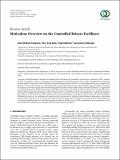Meticulous Overview on the Controlled Release Fertilizers

View/
Date
2014-08-28Author
Sempeho, Siafu Ibahati
Kim, Hee Taik
Mubofu, Egid
Hilonga, Askwar
Metadata
Show full item recordAbstract
Owing to the high demand for fertilizer formulations that will exhaust the possibilities of nutrient use efficiency (NUE), regulate
fertilizer consumption, and lessen agrophysicochemical properties and environmental adverse effects instigated by conventional
nutrient supply to crops, this review recapitulates controlled release fertilizers (CRFs) as a cutting-edge and safe way to supply crops’
nutrients over the conventional ways. Essentially, CRFs entail fertilizer particles intercalated within excipients aiming at reducing
the frequency of fertilizer application thereby abating potential adverse effects linked with conventional fertilizer use. Application
of nanotechnology and materials engineering in agriculture particularly in the design of CRFs, the distinctions and classification of
CRFs, and the economical, agronomical, and environmental aspects of CRFs has been revised putting into account the development
and synthesis of CRFs, laboratory CRFs syntheses and testing, and both linear and sigmoid release features of CRF formulations.
Methodical account on the mechanism of nutrient release centring on the empirical and mechanistic approaches of predicting
nutrient release is given in view of selected mathematical models. Compositions and laboratory preparations of CRFs basing on in
situ and graft polymerization are provided alongside the physical methods used in CRFs encapsulation, with an emphasis on the
natural polymers, modified clays, and superabsorbent nanocomposite excipients.
